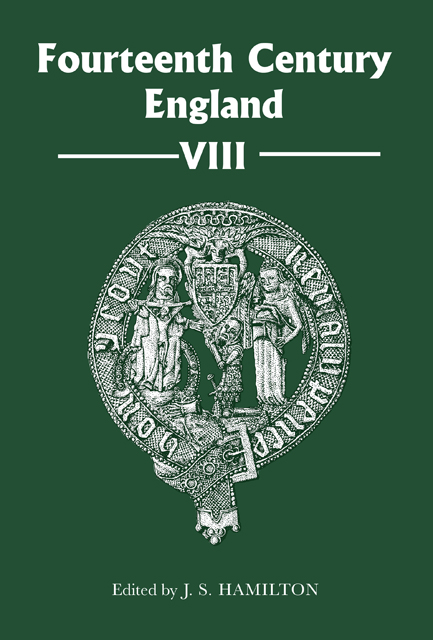Book contents
- Frontmatter
- Contents
- Contributors
- Preface
- Abbreviations
- King's Armourers and the Growth of the Armourer's Craft in Early Fourteenth-Century London
- In the Best Interest of the Queen: Isabella of France, Edward II and the Image of a Functional Relationship
- The First Entry of the Bishop: Episcopal Adventus in Fourteenth-Century England
- Temporalities Be Taken: Edward III, Unruly Ecclesiastics and the Fight for the Benefices of Exeter, 1337–60
- The Armour of Sir Robert Salle: An Indication of Social Status?
- Richard II, the Mortimer Inheritance and the March of Wales, 1381–84
- War, Chivalry and Regional Society: East Anglia's Warrior Gentry before the Court of Chivalry
- A ‘Sterre of þe See to ȝyue Lyȝt to Men’ and ‘Myrroure to Alle Sinful’: A Comparative Analysis of Biblical Women in the English Wycliffite Sermons with John Mirk’s Festial
- Index
- Fourteenth Century England issn 1471–3020
A ‘Sterre of þe See to ȝyue Lyȝt to Men’ and ‘Myrroure to Alle Sinful’: A Comparative Analysis of Biblical Women in the English Wycliffite Sermons with John Mirk’s Festial
Published online by Cambridge University Press: 15 February 2023
- Frontmatter
- Contents
- Contributors
- Preface
- Abbreviations
- King's Armourers and the Growth of the Armourer's Craft in Early Fourteenth-Century London
- In the Best Interest of the Queen: Isabella of France, Edward II and the Image of a Functional Relationship
- The First Entry of the Bishop: Episcopal Adventus in Fourteenth-Century England
- Temporalities Be Taken: Edward III, Unruly Ecclesiastics and the Fight for the Benefices of Exeter, 1337–60
- The Armour of Sir Robert Salle: An Indication of Social Status?
- Richard II, the Mortimer Inheritance and the March of Wales, 1381–84
- War, Chivalry and Regional Society: East Anglia's Warrior Gentry before the Court of Chivalry
- A ‘Sterre of þe See to ȝyue Lyȝt to Men’ and ‘Myrroure to Alle Sinful’: A Comparative Analysis of Biblical Women in the English Wycliffite Sermons with John Mirk’s Festial
- Index
- Fourteenth Century England issn 1471–3020
Summary
A late medieval English sermon penned during the last two decades of the fourteenth century describes Mary Magdalene as preaching. Her sermon was inspired after she witnessed a local lord in Marseilles offering sacrifices in a pagan temple.
Whan see Magdaleyn grete pepul comyng towarde þis tempul and þe lorde of þe cuntre to hau done offering and sacrifice to here mawmentis, but Mag// daleyne was so ful of grace of þe holy goste . þt scheo be hur gracious wordys turned hem alle aÈeyne hom. And for þis lorde sethe hyr ful of alle swet//nesse and gentryes. He had grete luste to heren hyr spekyn and sayde thus to hur. If thi God þt þai prechyst of is so grete of mythe as þu sayste pray to hym þt I may haue a chyles be my wyf þt is bareyne. And I will leven on hym.
Mary Magdalene acquiesced to the pagan lord’s request and his barren wife conceived a child, which Mary Magdalene – through another miracle – saved along with his newly delivered mother. The sermon concludes this story with a description of Mary Magdalene as a dynamic and persuasive preacher whose prayers not only produced miracles but whose words helped convert France to Christianity.
and whan þei [the lord and his newly saved wife and child] comyn hom . þei foundon Magdaleyne prechyng þe pepul and þan a none þei felon donn to hur fette. and thanked hyr wt alle here mythe and prayd hur to telle hem whatte þei schulde done and þei wolde wt glade herte. Þan Magda//leyn bad hem distroy þe tempulles of þt londe. And make þhe schyrches and revon fonts þt þe pepul myghte be cristened. And so in schorte tyme alle þe londe was turnyd to Cristen feyth þan for Magdaleyne.
This account of Mary Magdalene’s preaching is often associated with Lollardy, the English heresy conceived in the aftermath of John Wyclif’s reform movement. Indeed, the Lollard William Brut used Mary Magdalene as evidence of female preaching in his late fourteenth-century heresy trial.
- Type
- Chapter
- Information
- Fourteenth Century England VIII , pp. 147 - 164Publisher: Boydell & BrewerPrint publication year: 2014



